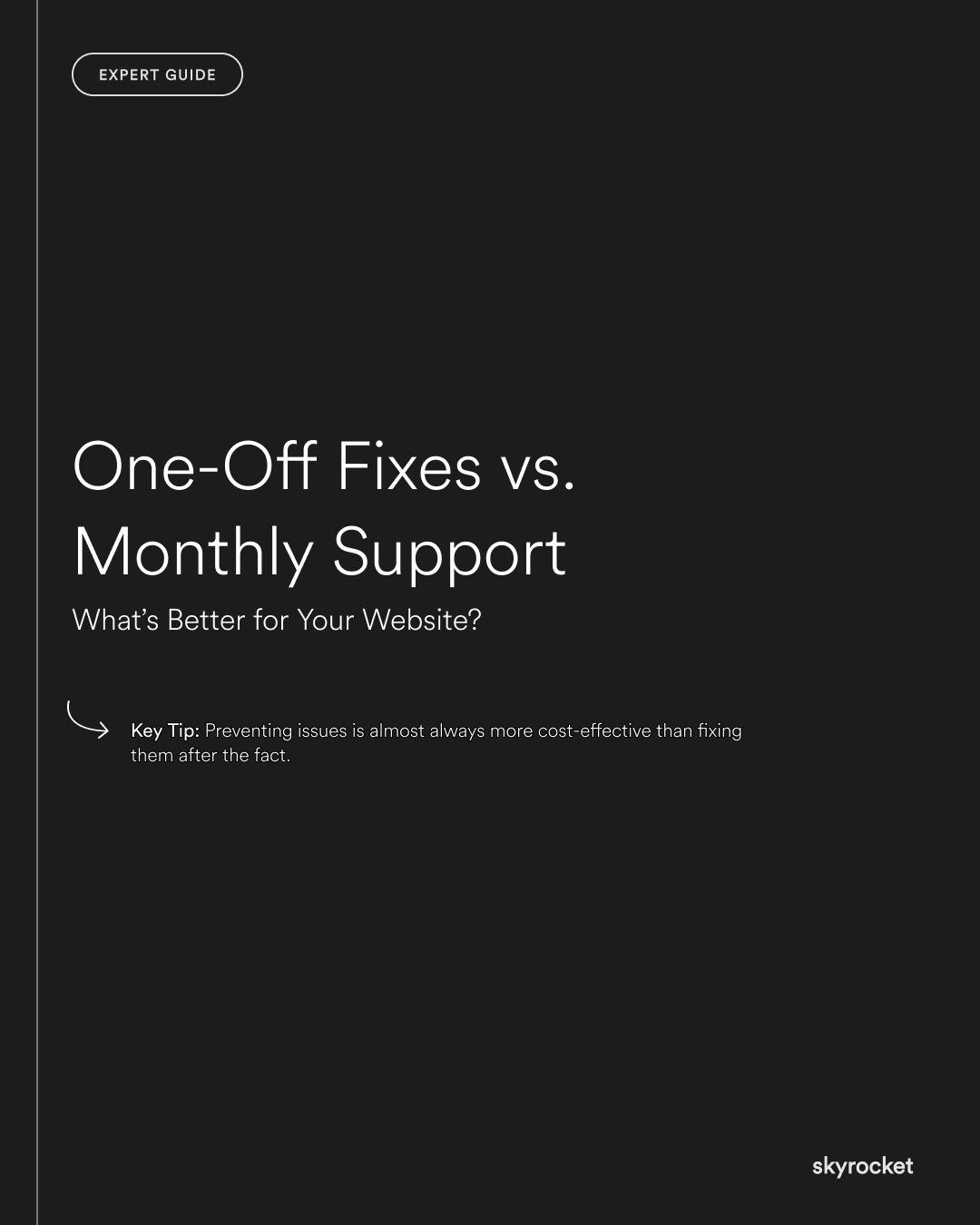Websites are never really “done.” They need looking after to keep working well, and as a business owner you’ve probably faced the choice: do you just patch things when they break, or invest in ongoing support?
On the surface, one-off fixes feel cheaper and easier. Something goes wrong, you get it sorted, and move on. But there’s a bigger picture to consider. A website is more than a digital brochure, it’s a living part of your business. How you maintain it affects performance, accessibility, and ultimately, how well it converts customers.
This guide unpacks the difference between one-off fixes and monthly support, the risks and benefits of each, and how to decide what makes sense for your business.
Key Tip: A single “cheap” one-off fix often costs more than planned support, because the same problems crop up again. Preventing issues is almost always more cost-effective than fixing them after the fact.
Why Website Maintenance Matters
You wouldn’t run a physical shop without keeping the lights on, fixing leaks, or rearranging the shelves. The same logic applies to your website. Regular upkeep makes sure:
- Customers can actually use the site without frustration
- Your content stays current and relevant
- The design feels fresh, not outdated
- Your site continues to rank well in search engines
- Accessibility is built in, so no one is excluded
Neglecting updates may save you money in the short term, but often leads to bigger problems that are harder and more expensive to fix.
The Case for One-Off Fixes
When they work
One-off fixes make sense in certain scenarios:
- You’ve identified a small, specific problem (e.g. a broken link or form not working)
- You’re testing a new business model and don’t want ongoing costs just yet
- Your site is simple, with limited functionality
The risks
- Problems creep back if the root cause isn’t addressed
- You miss updates that affect security or accessibility
- Fixes can cause unintended side effects elsewhere on the site
- Costs are unpredictable, which makes planning harder
One-off fixes are reactive by nature. They treat symptoms, not causes.
The Case for Monthly Support
When it makes sense
Monthly support is about being proactive. Instead of waiting for things to break, your site is monitored, updated, and improved on an ongoing basis. This is especially useful if:
- Your website drives sales or leads directly
- You rely on campaigns or seasonal promotions
- Your site has complex features like e-commerce or memberships
- Accessibility is important to your brand and customer experience
The benefits
- Predictability: You know what you’re spending each month
- Prevention: Small issues are caught before they snowball
- Performance: Regular updates keep things running smoothly
- Accessibility: Checks ensure everyone can use your site, not just some
- Scalability: Your site grows with your business, instead of falling behind
Monthly support isn’t about doing work for the sake of it. It’s about having experts on hand to keep your site aligned with business goals.
A Practical Way to Decide
So how do you choose between one-off fixes and monthly support? Here are some questions to ask yourself:
- How important is your website to your sales funnel?
If it’s a central driver, ongoing support is the safer choice. - Do you run promotions or seasonal campaigns?
These require planning and updates that benefit from consistent support. - How complex is your site?
The more features, the more that can break. - Do you have someone in-house who can manage updates?
If not, outsourcing support gives you peace of mind. - How much risk are you comfortable with?
If you’re okay with unpredictable downtime or costs, one-off fixes might work. If not, support is worth the investment.
Real-World Example
A retailer we worked with used to call in for one-off fixes every time their Shopify checkout had issues. Customers were dropping off, and the fixes were adding up.
Once they moved to monthly support, we set up a schedule for updates, tested checkout flows regularly, and kept accessibility in mind with every tweak. Conversion rates went up, and the business stopped losing sales to preventable problems.
The takeaway: they ended up spending less overall by investing in prevention, not patch jobs.
What to Do Now: Your Website Maintenance Checklist
- List the updates and fixes you’ve needed in the last year
- Add up the costs of those fixes, including lost sales from downtime
- Decide how central your website is to sales or leads
- Assess whether accessibility is consistently checked
- Weigh the risks of reactive fixes against the predictability of support
- Choose the model that gives you confidence, not just short-term savings
The Takeaway
There’s no one-size-fits-all answer. If your site is small and low stakes, one-off fixes may be fine. But if your website plays a key role in sales, promotions, or brand trust, monthly support usually pays for itself.
The smartest choice is the one that keeps your site sharp, accessible, and aligned with your business goals.
At Skyrocket, we offer support that keeps things simple and effective. If you’d like to explore what monthly support could look like for your site, get in touch.



